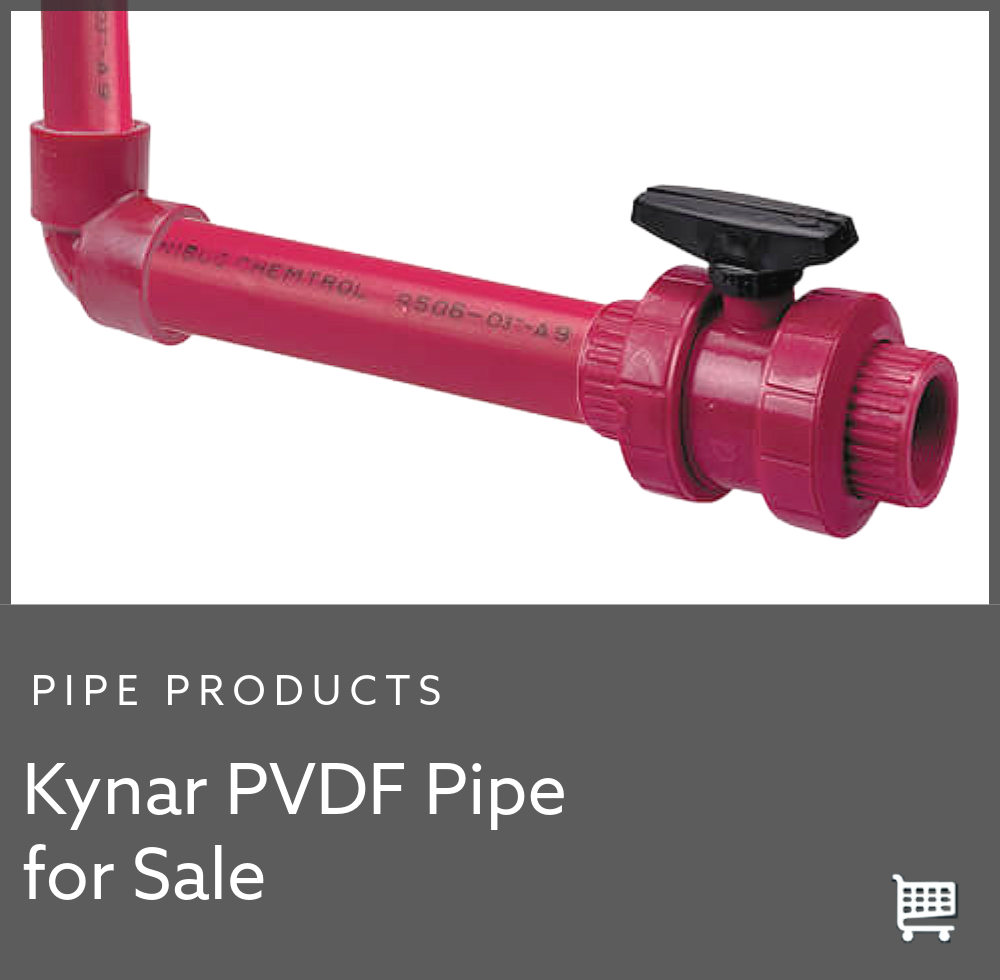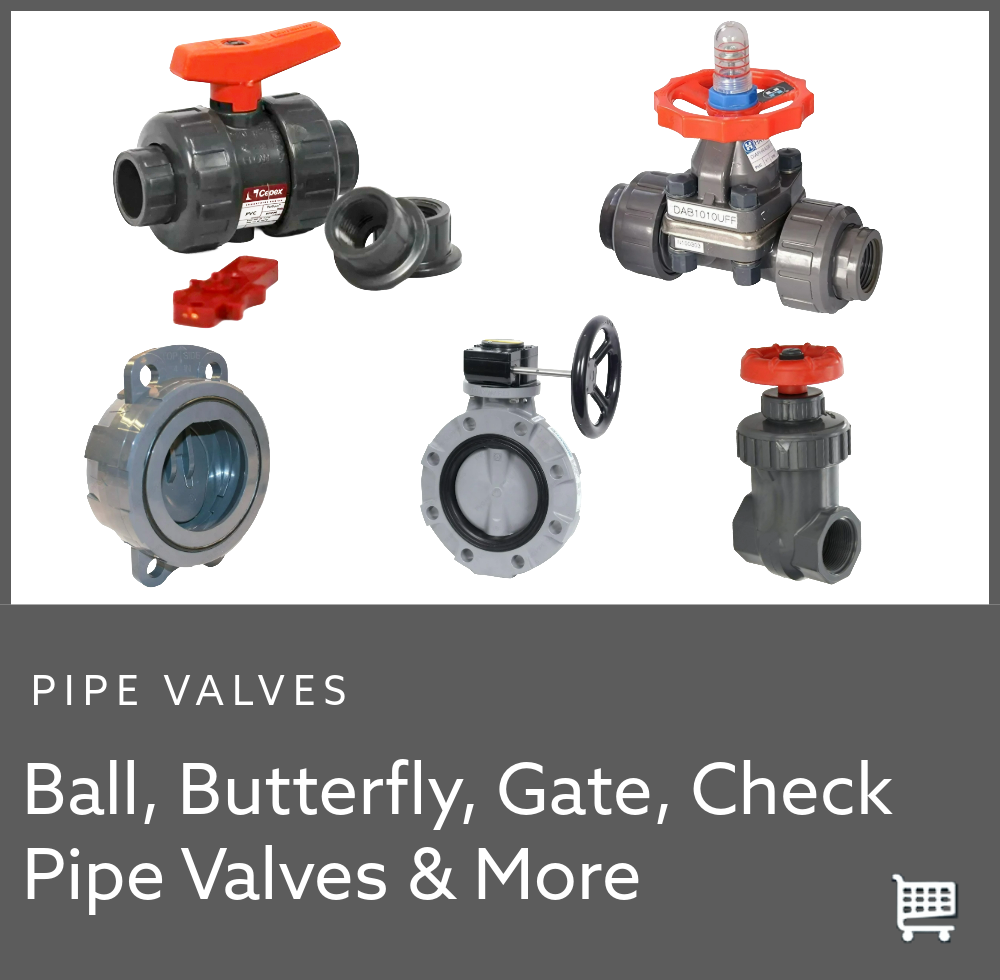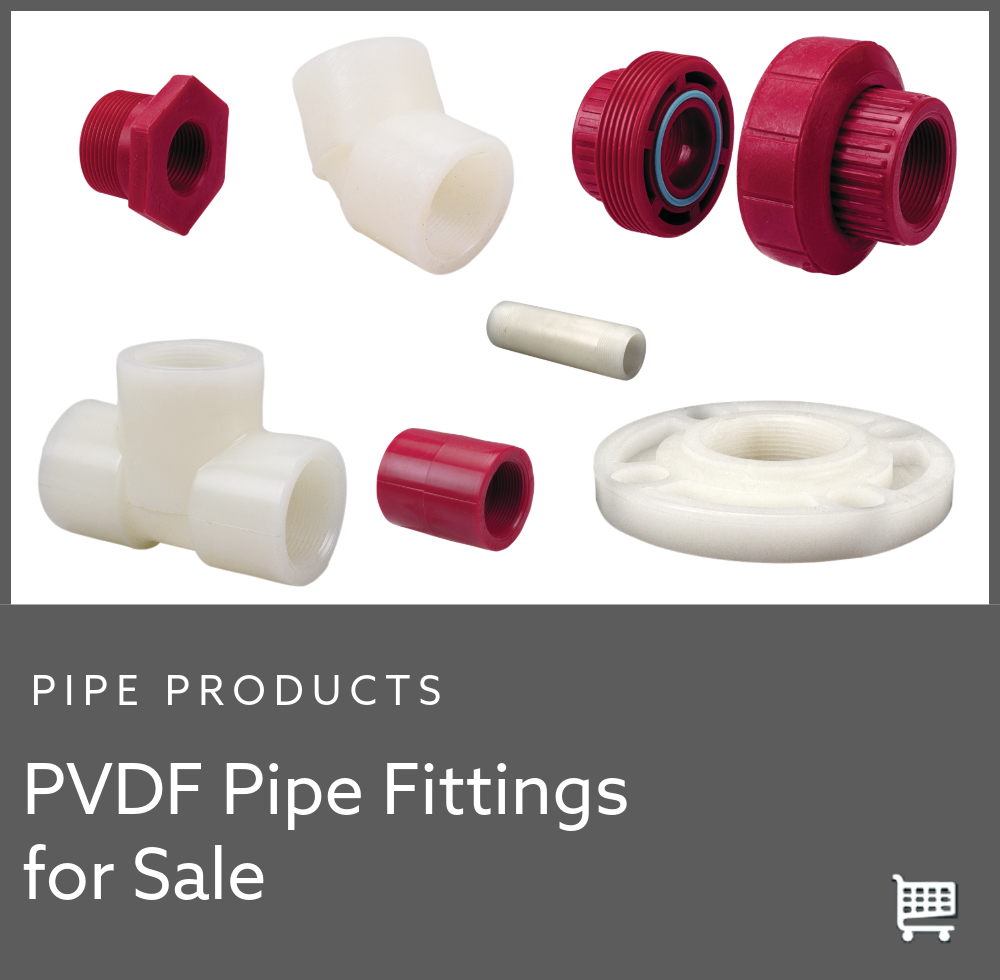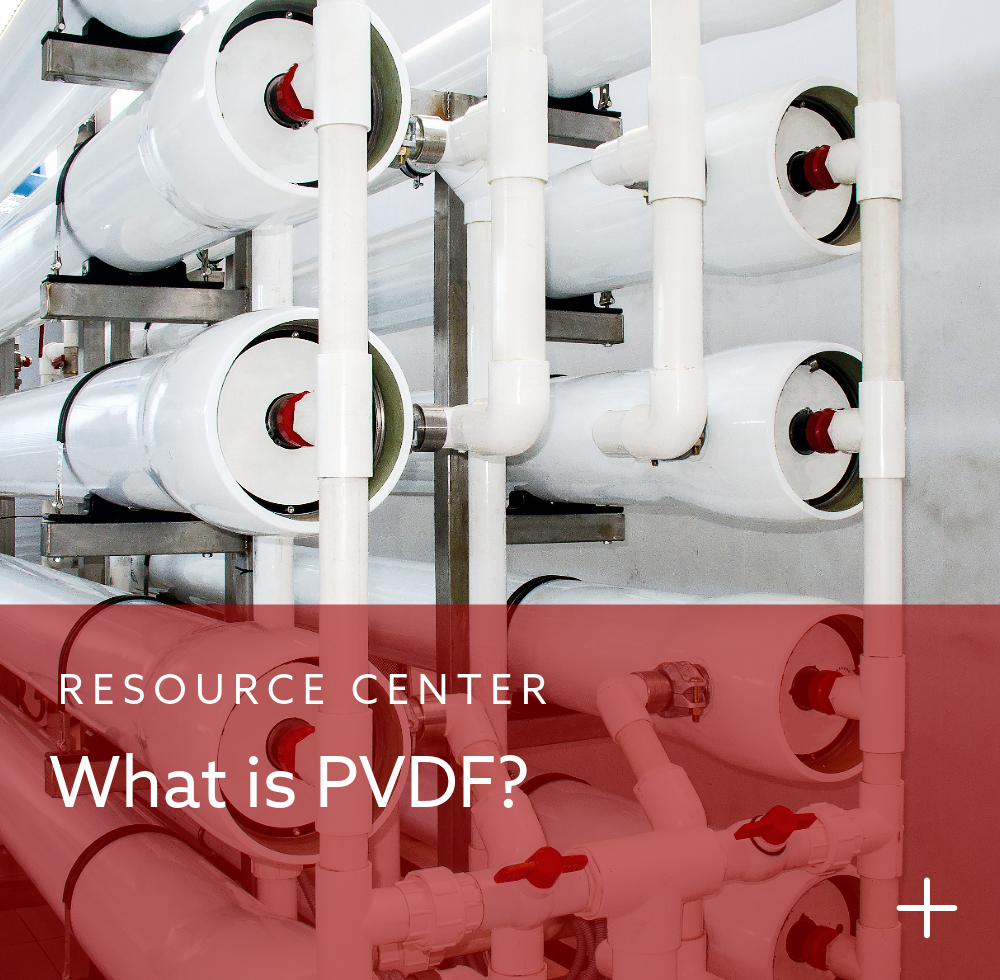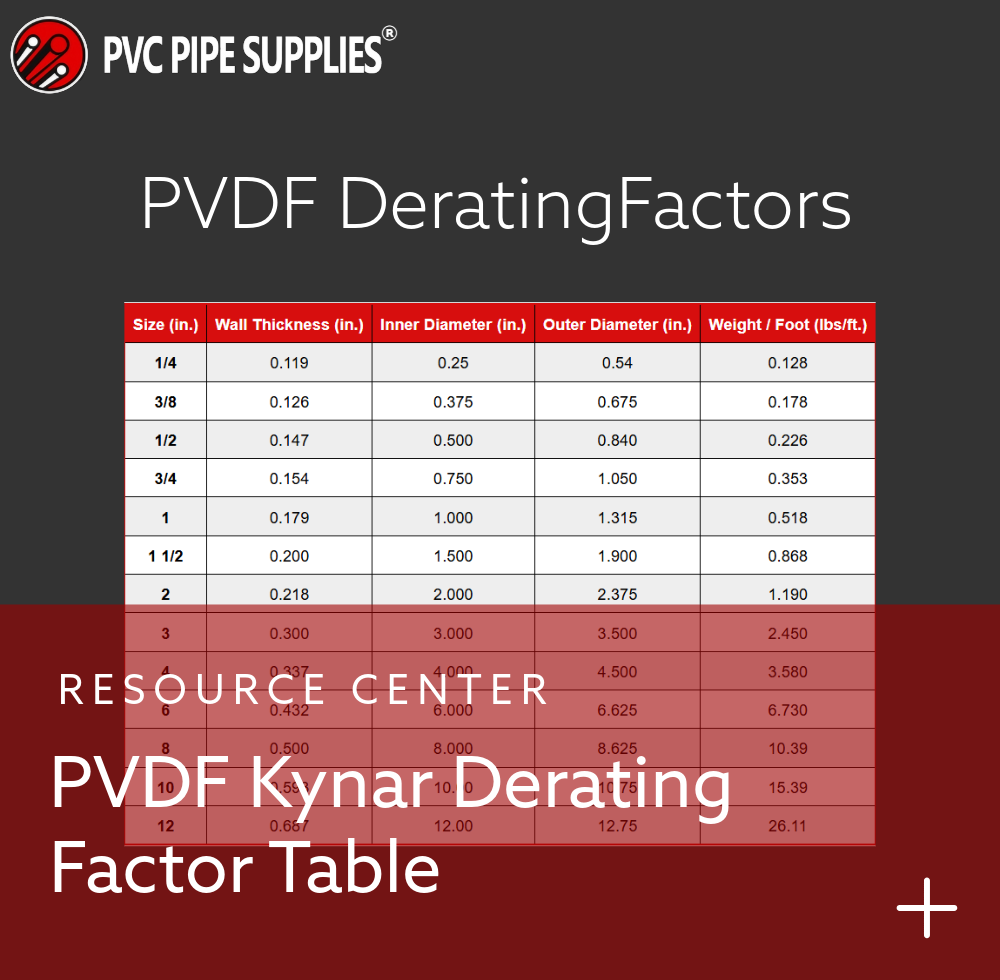General PVDF Overview
Polyvinylidene fluoride, or PVDF, is a high performance thermoplastic fluoropolymer known for its excellent strength and resistance against demanding work conditions and environments. A thermoplastic is a specific category that certain synthetic compounds are grouped into based on certain properties. Other common thermoplastics include PVC and polyethylene. PVDF is a fluoropolymer, meaning its chemical structure contains powerful carbon-fluorine bonds. This makes PVDF highly resistant to a broad range of chemicals, including strong acids, solvents, and hydrocarbons. This structure also gives PVDF improved thermal stability and allows it to operate in temperatures ranging from -40°F to 302°F (-40°C to 150°C) without losing its integrity.
What makes PVDF unique is its balanced combination of high performance traits in a single, processable material. Unlike many plastics, it is inherently resistant to UV radiation, and therefore, ideal for long term outdoor uses. PVDF also possesses unique piezoelectric properties, meaning it can generate an electrical charge in response to mechanical stress. This feature is leveraged in advanced applications like sensors and energy-harvesting devices.
Due to its high purity and durability, PVDF is a choice material in many industries. PVDF is used extensively in chemical processing for pipes and tank liners, in semiconductor manufacturing for ultra pure water systems, and in lithium ion batteries as a binder and separator. Its reliability and long service life make it one of the best options for applications where system failure is not an option.
Kynar® PVDF (Polyvinylidene Fluoride) is different from other fluoropolymers, like PTFE, due to its unique balance of properties and processing advantages. While all fluoropolymers offer excellent chemical and thermal resistance, Kynar PVDF provides superior mechanical strength, rigidity, and abrasion resistance. This makes it more suitable for structural components like pipes, valves, and fittings that must withstand the physical stress and harsh chemicals of plumbing systems.
Kynar PVDF is also significantly easier to process. It has a lower melting point than many other fluoropolymers, which allows it to be melt-processed using conventional techniques like injection molding and extrusion. It can also be easily welded, fabricated, and even used as a resin in high performance coatings. This property simplifies manufacturing and opens up a wider range of possible uses for PVDF.
Altogether, Kynar PVDF offers a unique combination of high level chemical inertness, robust mechanical properties, and ease of fabrication. This blend makes it a more versatile and often more cost effective solution for applications that need both durability and complex shaping. This, in turn, sets PVDF apart from more specialized fluoropolymers that may excel in one area but be more limited in others.
PVDF pipe and PVDF fittings are frequently used in industries where purity, chemical resistance, and thermal stability are critical. Common industries include semiconductor manufacturing, pharmaceuticals, chemical processing, and water treatment. In these sectors, there can be significant consequences should contamination or material failure occur. This makes PVDF’s reliability indispensable. Its ability to handle aggressive substances and maintain structural strength under extreme temperatures ensures safe, continuous operations.
The preference for PVDF in these industries is driven by the material’s properties. For semiconductor and pharmaceutical manufacturing, its high purity and low leachability prevent contamination of ultra pure water, sensitive compounds, and products that require the utmost level of cleanliness. In chemical processing, PVDF's greater resistance to acids, solvents, and other corrosive materials prevents system damage and protects long term safety, driving system reliability. For water and wastewater treatment, its ability to withstand harsh disinfectants like ozone and chlorine makes it a durable choice for long lasting filtration and transport systems.
PVDF Material Properties
Polyvinylidene Fluoride (PVDF) is valued for its elevated thermal stability with the ability to maintain its structural integrity and performance across a wide temperature range. The generally accepted operating temperature range for PVDF is from -40°F to 302°F (-40°C to 150°C). This broad range makes it a reliable choice for applications that will experience extreme cold and high heat. In terms of temperature stability, PVDF far surpasses the capabilities of common plastics like PVC and CPVC.
Within this operating range, PVDF remains strong, chemically resistant, and dimensionally stable. Decade long tests have been performed with no evidential changes to PVDF. At the low end, it resists becoming brittle, which is a common concern and point of failure for other polymers in cold environments. At the upper end, it retains its mechanical strength and does not soften or deform to stay reliable when transporting hot fluids or in high temperature industrial activities. This consistent performance under thermal stress is a common reason PVDF is used for applications in chemical processing, power plants, and other demanding fields.
Polyvinylidene Fluoride (PVDF) provides exceptional resistance to both ultraviolet (UV) and nuclear radiation, and is therefore a highly durable material for outside installations and high exposure systems. Unlike many other plastics that degrade, discolor, or become brittle when exposed to prolonged sunlight, PVDF's inherent chemical stability allows it to maintain its physical properties and appearance over decades. This makes PVDF ideal for architectural coatings, solar panel components, and outdoor chemical piping systems with confidence for lasting performance and without concern for weather related failure.
PVDF's resilience also applies to energy radiation exposure. It can withstand significant levels of gamma and other nuclear radiation without compromising its structural integrity. Government and industry testing have shown that PVDF can endure high radiation doses (up to 1,000 Mega-Rads) with minimal negative effects. This unique characteristic makes it a trusted material for applications in the nuclear industry, including waste handling and equipment used within reactor environments where other materials would quickly fail.
Kynar pipe and PVDF fittings offer excellent resistance to a wide range of aggressive chemicals, making them suitable for demanding industrial applications. PVDF is largely inert to strong acids (such as sulfuric and nitric acid), aliphatic and aromatic hydrocarbons, alcohols, and halogenated solvents like chlorine and bromine. This high level of resistance is due to the strong carbon-fluorine bonds in its molecular structure, which prevent chemical attack and degradation.
However, like any material, PVDF is not immune to all chemicals. PVDF has limited resistance and may experience softening or swelling when exposed to highly polar solvents such as ketones (like acetone) and esters. Also, it is generally not recommended for use with strong bases or caustic solutions, such as sodium hydroxide, or fuming acids, as these can weaken its integrity over time. Always verify compatibility with specific chemicals and concentrations before use.
Yes, PVDF is widely considered safe for applications involving food contact and pharmaceutical processing. It is an extremely pure, high grade polymer that does not contain additives, stabilizers, or plasticizers that could leach into the materials it contacts. This high level of purity ensures that it will not contaminate sensitive products, making it an ideal choice for systems that require hygienic conditions.
PVDF manufacturing complies with strict regulatory standards, including those set by the FDA for food contact materials. Its non-toxic and non-reactive nature, combined with its resistance to microbial growth and common sterilization methods, makes it a trusted material for producing ultra pure water, processing food and beverages, and manufacturing pharmaceutical products.
PVDF is capable of providing reliable performance in a variety of extreme environmental conditions where many other plastics would fail. PVDF piping excels in environments with high humidity and saltwater, which makes it suitable for marine and coastal applications. Its low water absorption rate ensures its mechanical properties remain stable even when fully submerged.
PVDF also provides exceptional performance in extreme cold with the ability to maintain its flexibility and resist brittleness at temperatures as low as -40°F (-40°C). All while preventing cracks and failures common in other polymers.
PVDF’s mechanical properties offer a valuable combination of strength, toughness, and flexibility unique from other fluoropolymers. It exhibits high tensile strength and rigidity, which allows its use for structural components like pipes and fittings that must withstand significant operational stressors without deforming. PVDF has good impact resistance and is less prone to cracking than many other hard plastics. Its abrasion resistance is also superior to that of most thermoplastics, resulting in long service lives even in abrasive slurries or high flow applications.
The following are general property values for PVDF pipe; note that actual values can vary depending on pipe size, grade, and manufacturer:
- Tensile Strength: Ranges from 5075 to 7250 psi (35 to 50 MPa) at 73°F (23°C).
- Flexural Strength: Approximately 2100 psi (11.165 MPa).
- Impact Strength: The Izod impact strength for PVDF is 2.25 ft-lbf/in (120 J/m) at 73°F.
- Elongation at Break: PVDF can elongate by 20% to 50% before breaking.
- Compressive Strength: Ranges from 70 to 100 MPa, depending on the specific grade.
- Hardness: Scores between R110 and R115 (Rockwell Hardness Scale), indicating high resistance to surface damage.
- Abrasion Resistance: Taber abrasion loss of 5-10 mg/1000 cycles, superior to many other thermoplastics.
- Young’s Modulus (Elastic Modulus): PVDF stiffness ranges from 2.5 to 3.5 GPa.
Due to its inherent UV resistance, PVDF piping has the same lifespan whether it is installed outdoors or inside. Unlike most plastics that degrade, chalk, or become brittle after prolonged exposure to sunlight, PVDF maintains its color, flexibility, and mechanical strength for decades. This outstanding durability makes it a superior material choice for long term outdoor use.
This weatherability is most famously demonstrated in PVDF-based architectural coatings, such as Kynar 500®, which are warrantied to resist fading and degradation for 20 years or more. For PVDF pipes, sheets, and other solid components used outdoors, the expected lifespan is even longer, as the material resists environmental stress cracking and degradation from exposure to sun, rain, and temperature changes. Collectively, this makes PVDF a "fit and forget" solution for many outdoor industrial and construction applications.
PVDF Installation and Maintenance
The most reliable and effective way to join PVDF pipes and fittings is thermal fusion welding, as this creates a strong, permanent, and leak proof seal by melting and fusing the material together. However, the specific fusion technique chosen often depends on the pipe size, application requirements, and sometimes comes down to available equipment. Common PVDF fusion techniques include butt fusion, socket fusion, and electrofusion, all of which produce joints that are as strong as the pipe itself.
For larger diameter pipes, butt fusion is the preferred method. This technique involves heating the squared ends of two pipes with a specialized tool and then pressing them together under controlled pressure until they form a homogenous bond. Socket fusion is typically used for smaller diameter pipes and involves heating the outside of the pipe end and the inside of a fitting before joining them. Electrofusion uses special fittings with embedded heating coils that melt the pipe and fitting together when an electric current is applied. This option is ideal for repairs or tight spaces.
No, Kynar PVDF piping cannot be reliably joined using solvent cements, glues, or conventional adhesives. Its chemical structure gives it exceptional resistance to solvents and other chemicals and effectively prevents adhesives from creating a strong, lasting bond. The surfaces of PVDF are non-porous and have a low surface energy, which means glues cannot properly wet and adhere to the material so as to form a structural connection as it does in other plastic piping.
Because adhesive bonding is not a viable option, thermal fusion welding is the industry standard method for creating permanent PVDF pipe connections. To create non-permanent connections, use PVDF flanges or threaded fittings. These options can still provide leak free performance without relying on chemical bonding.
In general, PVDF plumbing systems require minimal maintenance due to their high purity, smooth internal surfaces, and overall resistance to chemical and biological buildup. For basic cleaning, flushing the system with high purity water is often sufficient. If more intensive cleaning is needed, steam cleaning is highly effective and safe, as PVDF can easily withstand the high temperatures.
When chemical cleaning is necessary, first verify that the cleaning agents are compatible with PVDF. While PVDF is resistant to many chemicals, it can be damaged by strong bases, ketones, and esters. Always consult a chemical compatibility chart and follow manufacturer guidelines before introducing any cleaning solution into the system. Regular visual inspections for any signs of mechanical damage or stress are also a good maintenance practice.
A common mistake during PVDF installation is poor preparation and execution of the welding process. This includes:
- Failing to properly face and clean pipe ends
- Using incorrect heating temperatures or times
- Applying inconsistent pressure during fusion
These errors can result in weak or incomplete joints that can become prone to leaks and failure over time or when exposed to pressure. Always follow precise manufacturer guidelines for the specific welding equipment.
Another common error is applying excessive mechanical stress to pipes and fittings during installation. Examples:
- Over-tightening mechanical joints
- Creating sharp bends without proper supports
- Failing to account for thermal expansion and contraction
These can all introduce stress points, which, over time, can lead to cracks or structural failure. Always ensure proper alignment, use correct support spacing, and respect the material's bend radius to prevent these issues.
Installing PVDF pipework requires tools for thermoplastic fusion welding. The specific equipment depends on the joining method. For butt fusion, you will need a butt fusion welding machine, which includes a heater plate, a facer tool for squaring pipe ends, and clamps for alignment. For socket fusion, you will need a thermostatically controlled heating tool with male and female heater adapters.
In addition to the welding machines, other tools needed include:
- A quality pipe cutter designed for plastic pipe to achieve clean, square cuts
- Deburring tools to remove any burrs from the pipe end before welding
- For quality control, measuring tools like calipers and depth gauges to check weld bead size and insertion depths
- Personal protective equipment, such as heat resistant gloves and safety glasses
Visual inspection is the primary method for monitoring the condition of a PVDF piping system. Look for any signs of mechanical damage, such as cracks, gouges, or discoloration, which might indicate chemical attack or excessive stress. Pay close attention to joints and connection points, as these are often the first areas to show signs of a problem. Also, check for any deformation or sagging of pipes between supports, as this could indicate a loss of structural integrity.
It is also important to monitor the system's operational performance. Unexpected pressure drops, changes in flow rates, or evidence of even minor leaks should be investigated immediately. For critical applications, more advanced non-destructive testing methods, like ultrasonic inspection, can be used to detect subsurface flaws or changes in wall thickness without having to shut down the system.
PVDF Applications and Use Cases
PVDF plumbing is preferred in the chemical processing industry due to its superior chemical resistance and high purity. It can safely handle a range of aggressive substances, including strong acids, halogens, and hydrocarbons, without corroding or degrading. The result: long term integrity of Kynar piping systems, reduced risk of hazardous leaks, and minimal downtime and repair costs. Its reliability makes PVDF pipe ideal for conveying corrosive liquids, where, due to safety and productivity, system failure is not an option.
Also, PVDF has an inherent purity and contains no additives or plasticizers that could leach into and contaminate the transported fluid. This is a significant advantage for applications where chemical purity is essential for final product quality. Altogether, the combination of high level chemical resistance, purity, and thermal stability causes PVDF to be a safe and dependable solution for many of the most challenging chemical handling conditions.
In water treatment, PVDF is primarily used to build filtration membranes and plumbing systems. Its chemical resistance makes PVDF suitable for handling the aggressive disinfectants commonly used in water and wastewater treatment, such as chlorine, ozone, and other oxidizing agents. Unlike other materials that can break down over time when exposed to these chemicals, PVDF has been proven to maintain its structural integrity for a long, reliable service life.
PVDF pipe has a high strength, smooth, and non-porous surface that prevents biofilm growth and reduces fouling. These properties work together to maintain an efficient system and lower maintenance needs. Whether used in membrane bioreactors (MBRs), for reverse osmosis pre-treatment, or in chemical dosing piping, PVDF provides a robust solution for modern water treatment facilities.
PVDF pipe is highly suitable for the semiconductor industry because of its certified purity and chemical resistance capable of meeting the industry’s strict standard requirements. The manufacturing of microchips requires the use of ultra pure water (UPW) and aggressive chemicals, and operates under conditions where even the slightest contamination can lead to defects and significant financial losses. PVDF piping systems are manufactured without stabilizers, lubricants, or other additives, so they can be trusted to not leach impurities into the high purity fluids they transport.
In addition to its purity, PVDF’s smooth, non-porous surface resists the adhesion of microbes and the formation of biofilm, which helps maintain the cleanliness of the process environment as well as make maintenance easier. PVDF pipe’s ability to withstand the chemicals and high temperatures commonly used in the industry makes it a dependable choice for the entire fluid handling network within a semiconductor fabrication plant.
An important trend emerging is the integration of PVDF components with Internet of Things (IoT) technology. By embedding sensors into PVDF pipelines and plumbing systems, companies can achieve real time monitoring of flow rates, pressure, and conditions. Such real time data enables predictive maintenance, early leak detection, and more efficient operations, making "smart" fluid handling systems a reality.
The primary advantages of PVDF in high purity applications, such as in the pharmaceutical and semiconductor industries, are:
- Superior level of purity; manufactured without additives that could leach out and contaminate.
- Highly stable molecular structure that resists chemical and thermal damage.
- Smooth, non-porous internal surface that resists microbial adhesion and biofilm development.
- Easy to clean and compatible with sterilization methods.
Collectively, these properties work together to ensure that the final product, whether it is a medication or a microchip, remains free from impurities.
Advanced Topics
PVDF pipe is a high performance product that offers significantly greater capabilities than common plastic piping like PVC and CPVC. The popular difference is PVDF’s chemical and thermal resistance. PVDF can safely operate at temperatures up to 302°F (150°C), while PVC and CPVC have much lower maximum service temperatures of 140°F (60°C) and 200°F (93°C), respectively. PVDF also resists a broader range of aggressive chemicals, including strong acids and solvents that would quickly degrade PVC and CPVC.
Regarding cost, however, PVDF piping has a higher purchase price. PVC and CPVC are more economical and therefore more suitable from a budget standpoint for general-purpose applications like residential and commercial plumbing, low pressure water systems, and certain chemical applications. For demanding industrial environments involving high temperatures, corrosive chemicals, or high purity requirements, PVDF’s durability, extended service life, and unmatched reliability provide greater long term value and safety that justifies the investment.
PVDF is considered a stable and safe material with favorable environmental considerations. It is a fluoropolymer, but differs from certain controversial PFAS compounds because it is a stable, solid thermoplastic that is not water soluble. Nor does it readily break down in the environment. Its durability and long service life—often spanning decades—mean that components need to be replaced less frequently, which in turn reduces overall material consumption and waste.
From a regulatory view, PVDF is widely approved for use in sensitive applications. It meets the FDA standards for food contact and is heavily used in drinking water, food and beverage processing, and pharmaceutical production systems due to its high purity and non-toxic rating. While recycling PVDF can be challenging, it is technically possible through specialized processes, and industry innovators continue to explore more sustainable end-of-life options.
The production of PVDF, like many industrial polymers, is an energy intensive process that involves the synthesis of its core monomer, vinylidene difluoride. The process relies on raw materials derived from the petrochemical industry and makes use of various chemicals and catalysts. Manufacturers continue to optimize production methods to reduce energy consumption, minimize wastes, and improve overall process sustainability.
Disposal of PVDF presents both challenges and benefits. Because of its extreme durability and chemical resistance, PVDF does not readily decompose in landfills, making it a persistent material. However, this same durability makes it a good candidate for long term use and potential recycling. Specialized mechanical and chemical recycling methods can reclaim PVDF resin for reuse, though the infrastructure for this is still developing and improving. End-of-life protocols should be considered alongside PVDF implementation with the aim to minimize its overall environmental footprint.
Troubleshooting and Concerns
While PVDF is a high performance material, it has a few limitations to consider. Its primary drawback is its installation, which is more complex compared to common plastics like PVC and CPVC, and requires specialized thermal fusion welding equipment and trained technicians to achieve leak free joints.
PVDF also has certain chemical sensitivities. Specifically, it can be attacked by highly polar solvents such as ketones and esters, as well as strong bases and particular caustic solutions. Such exposure can cause material swelling, softening, or degradation. Therefore, always verify chemical compatibility before specifying PVDF for a particular application.
PVDF pipes and fittings have exceptional durability and a long service life potential with the ability to last for several decades. Under proper operating conditions—within its recommended temperature, pressure, and chemical compatibility limits—a PVDF plumbing system can be expected to perform reliably for 20 to 50 years or even longer. Its natural resistance to UV radiation, abrasion, and chemical attack prevents it from degrading in the same way as many other plastics.
PVDF’s actual lifespan can be negatively affected by several factors, including:
- The intensity of UV or radiation exposure
- The concentration of chemicals being transported
- The temperature of handled fluids
- The quality of the installation
- Systems that experience frequent thermal cycling or mechanical stress may also experience a shorter lifespan
However, in well designed and properly installed systems, PVDF pipe can be trusted to provide outstanding long term value and reliability.
The most obvious sign of a PVDF system failure is a leak, which can be categorized as a slow drip to a complete rupture. Other visual indicators to watch for during routine inspections include:
- Discoloration, particularly darkening or yellowing of the pipe material, which can be a sign of chemical attack or thermal degradation from extensive use.
- Brittleness or the presence of fine surface cracks (crazing), which can indicate material fatigue or incompatible chemical exposure.
- Physical deformation, such as sagging or bulging in the pipes, which could suggest structural integrity loss, such as from excessive temperature or pressure.
- Poor weld beads or stress signs around joint connections, which could become a cause for concern and may benefit from replacement.
Continuous monitoring of the system’s pressure and flow rates can help identify potential issues as they are occurring or before they escalate, as a gradual pressure drop may indicate a developing leak.
If a PVDF pipeline fails, the first step is to safely shut down and isolate the affected section to prevent any further leaks or potential hazards. Once the area is secure, conduct a thorough inspection to determine the cause and extent of the failure. Look for evidence of cracking, chemical attack, mechanical damage, or faulty joints. Identifying the root cause can help prevent a repeat event.
For repairs, the damaged pipe section or the failed fitting must be cut out and replaced. The new part can be integrated into the system using PVDF thermal welding techniques. Or mechanical couplings or flanges can be used to connect replacement parts. Always follow proper installation procedures to ensure a strong, reliable repair.
If a chemical spill occurs from a PVDF system, immediately follow established safety protocols for the specific chemical involved. This typically includes containing the spill, neutralizing the substance if necessary, and ensuring the area is well ventilated. All personnel should wear appropriate personal protective equipment (PPE). Once the external spill is managed, the source of the leak in the piping system must be identified and repaired.
If the concern is internal contamination, especially for high purity systems, the line must be isolated and thoroughly flushed. The cleaning procedure will depend on the contaminant. High purity water is often used, but steam cleaning is also an effective and acceptable method for PVDF. If chemical cleaning is required, always use a cleaning agent fully compatible with PVDF to avoid damaging the system.
While PVDF is versatile, other materials may be more suitable for certain applications. For lower temperature, less corrosive environments where cost is a primary factor, PVC pipe and CPVC pipe are common and trustworthy alternatives. For applications that require extreme or specific chemical resistance, especially against strong bases and solvents where PVDF is weaker, other fluoropolymers like PTFE, FEP, or PFA may be better choices, though they are often more expensive and complex to install.
For high strength applications that require chemical and high pressure resistance, metal piping such as stainless steel or carbon steel is often used. These materials provide superior mechanical strength but can be susceptible to corrosion from certain chemicals. The best alternative will depend on a careful evaluation of the application's specific requirements, including chemical exposure, temperature, pressure, purity, and budget.
Buy Professional Grade PVDF from Trusted Suppliers
Have more questions or need guidance on selecting the right PVDF piping? Bidding a project and interested in bulk order, contractor discounts? Contact us today to find the perfect solution for your industrial needs.
Buy Professional Grade PVDF from Trusted Suppliers
Have more questions or need guidance on selecting the right PVDF piping? Bidding a project and interested in bulk order, contractor discounts? Contact us today to find the perfect solution for your industrial needs.

